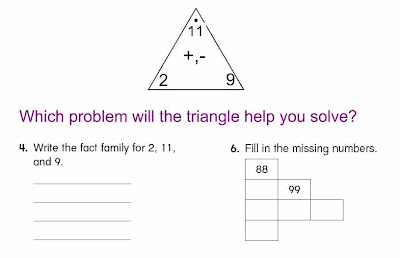
We notice that sometimes students have trouble making connections. eg. Students on a recent progress check confused the idea of fact families when simply asked to write the fact family for 2,9,and 11. They were able to do the task when given a fact triangle. We now have to think of ways to help them know when to make a connection with those fact triangles as a strategy.
idea: put triangles into the gallery available at our finger tips. Teach students when to use the fact triangle by showing them two questions: one where the fact triangle is useful and one where it is not. Ask the question,Which problem will the triangle help you solve?
Diane and Linda
The next night I was reading the article, Nine Ways to Catch Kids Up, by Marilyn Burns. I it was as if I was reading the about the discussion Diane and I had. The big idea here is to MAKE CONNECTIONS EXPLICIT! Here is part of that article, if you work at CSD email me and I will copy the whole thing for you if you are interested.
5. Make Connections Explicit
Students who need intervention instruction typically fail to look for relationships or make connections among mathematical ideas on their own. They need help building new learning on what they already know. For example, Paul needed explicit instruction to understand how thinking about 6 * 8 could give him access to the solution to 6 * 9. He needed to connect the meaning of multiplication to what he already knew about addition (that 6 * 8 can be thought of as combining 6 groups of 8). He needed time and practice to cement this understanding for all multiplication problems. He would benefit from investigating six groups of other numbers - 6 * 2, 6 * 3, and so on - and looking at the numerical pattern of these products. Teachers need to provide many experiences like these, carefully sequenced and paced, to prepare students like Paul to grasp how 6 * 9 connects to 6 * 8.

No comments:
Post a Comment